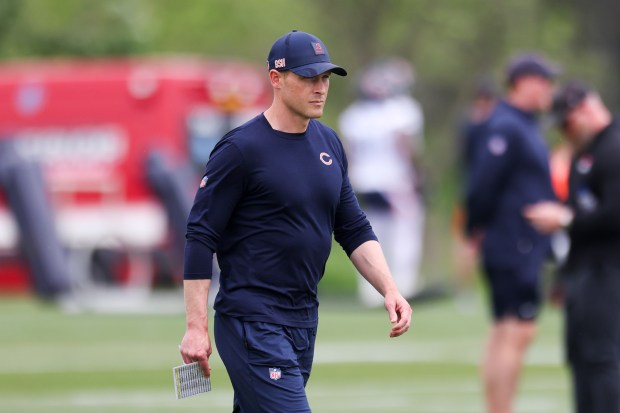Aneesah Morrow was never coming out of that game.
Not a chance. Not with LSU trailing by five points in the final quarter of an Elite Eight matchup with No. 1 seed UCLA. Not with a trip to the Final Four on the line.
When Morrow crumpled to the court in the final 90 seconds of the third quarter, blood dripping from her nose onto the hardwood, it seemed that LSU’s game was about to collapse with her.
It was a fluke collision. Teammate Sa’Myah Smith slammed Morrow’s face with the back of her head after being knocked backward by UCLA star Lauren Betts. But that accident forced Morrow to the locker room in one of the most crucial stretches of the season for the Tigers.
There was no time for a mask or any other measures. So Morrow played the final 9 minutes and 34 seconds of her collegiate career with her face unprotected, the bridge of her nose visibly swollen out of shape. She set screens with her shoulders squared firmly, swatted offensive rebounds and poked at loose dribbles.
With 74 seconds remaining, Morrow scored a layup off a dish from Flau’jae Johnson to cut the lead to seven. But no act of heroism from Morrow was enough to lift the Tigers over the top-ranked team in the nation. She fouled out in the final 26 seconds as UCLA grinded out a 72-65 victory.
It wasn’t the ending Morrow wanted. She finished her collegiate career as the third-best rebounder in NCAA women’s basketball history. After starting at DePaul, Morrow elevated herself into a potential WNBA draft lottery pick through her final two years with LSU. But Morrow wanted more — a trip to the Final Four, a chance to fight for the first and last championship of her career.
Still, the final outing of Morrow’s prestigious collegiate career proved the point she’s been trying to make since she first picked up a basketball in Chicago — she will never back down.
“I put a lot on my shoulders to come out and do what I did every night,” Morrow said after the loss. “Nobody in the country did what I did every night. Nobody in the country did what I did over these four years. I’m honestly just proud of myself for overcoming as much as I overcame and being able to do it at the biggest level.”
Morrow never shook her identity as an underdog.
She was a standout at Simeon — winning the city championship as a freshman, making All-State as a senior — but never garnered interest from top programs. Morrow’s best offers came from DePaul, St. John’s and Rutgers. Despite being an NCAA statistical leader throughout her first two years with the Blue Demons, Morrow was regularly looked over in national conversations.
“I do feel like I’m kind of overlooked,” Morrow told the Tribune during her sophomore season with DePaul. “I feel like numbers don’t lie — and at the end of the day, my numbers are not lying.”
And it happened again this year as a high-profile senior with LSU. Despite leading the league in rebounds, tallying 26 double-doubles and winning SEC Defensive Player of the Year, Morrow was passed over for SEC Player of the Year in favor of Texas center Madison Booker. The snub only added to Morrow’s postseason campaign.
Part of this phenomenon is fueled by her perceived disadvantage. At 6-foot-1, Morrow is substantially smaller than most elite forwards in both the NCAA and WNBA. But Morrow has been trying to explain this for years: size doesn’t matter.
Morrow will scrap with any player for a rebound, including her own teammates. Former LSU teammate and current Chicago Sky star Angel Reese joked about this phenomenon on social media after Morrow grabbed 19 rebounds against NC State: “Me (and) Nees gon be killing each other for rebounds in the W.”
This is nothing new. Morrow led the NCAA in rebounds as a freshman at DePaul, a year in which she was named Freshman Player of the Year and finished as the only freshman finalist for the Wooden Award and Naismith Defensive Player of the Year.
Morrow set DePaul’s single-season scoring record as a sophomore before transferring to LSU, where she was named first team All-SEC and became a finalist for the Cheryl Miller Award as a junior. She scored her first 1,000 points in only 43 games.
As a senior, Morrow became only the second Division I men’s or women’s basketball player to record 100 career double-doubles — a record previously held solely by new Chicago Sky assistant coach Courtney Paris, who first set the milestone in 2009.
Skills can be coached. Physicality can be improved. But Morrow’s motor is something that can’t be taught. And at every turn of her career, her success was predicated on a simple, unimpeachable desire to dominate her opponent.
“That kid — she just works,” LSU coach Kim Mulkey said. “She just is one you want on your team. She plays that hard in practice every day. Sometimes you put her on the side because it’s like, ‘Nees, this is one of those days where you can take a deep breath.’”
There were plenty of reasons why Morrow chose DePaul for her first two years of college. There weren’t many offers. Her mother, Nafeesah, had been recruited by longtime coach Doug Bruno decades prior before she ultimately chose Nebraska, where she led the Huskers to a first-ever NCAA win and met Aneesah’s father, Ed.
But most of it — if she was being honest — was because Morrow didn’t want to stray far from home.
Morrow has never shied away from the hard parts of growing up on the South Side. Life wasn’t always easy. She saw shootings in her neighborhood, outside her grandfather’s house, on the street outside her family home.
But Morrow loves Chicago. She loves being from Chicago. Even when Morrow headed south to Baton Rouge to challenge herself in her final two years of college, that part remained the same — a love and gratitude for her community, for her family and for the city that raised her.
“My parents have been through a lot of stuff and I’ve been through a lot of stuff,” Morrow said. “I’ve seen things that I shouldn’t have seen. I’ve been in crossfire. I’ve been through it all, honestly, being on the South Side. The sacrifices that they’ve made for me — I just never want them to worry about anything. And I never take anything for granted.”
If Morrow ever comes home to Chicago, it won’t happen this year.
The Sky traded out of the draft lottery to acquire Ariel Atkins earlier this year. And with Morrow predicted to become a top-6 selection, the forward is likely to be long gone by the time the Sky are on the clock for the No. 10 pick.
If anything, Morrow’s draft stock has been held back by her unconventional fit on a roster. She carved out an identity as an undersized forward, battling against posts who towered inches above her. But analysts and front offices alike are wary about her lack of 3-point shooting volume, which could make her an awkward fit at both the four and five positions as a professional.
In the NCAA Tournament, Morrow previewed her potential to answer those questions, knocking down a pair of 3-pointers in the Sweet 16 and one more against UCLA.
“For you WNBA scouts — I think she lit it up from out there,” Mulkey said after LSU’s Sweet 16 win. “I think they forget she can shoot the three ball because that’s all she did when she was at DePaul. But for us, it’s not needed.”
But wherever Morrow is headed next, Chicago will follow.
Morrow will carry the legacy of the city — the toughness, the intellect, the refusal to be intimidated — on her shoulders when she enters the WNBA.
And the city will carry its own point of pride: that everything Morrow accomplished started right here.



